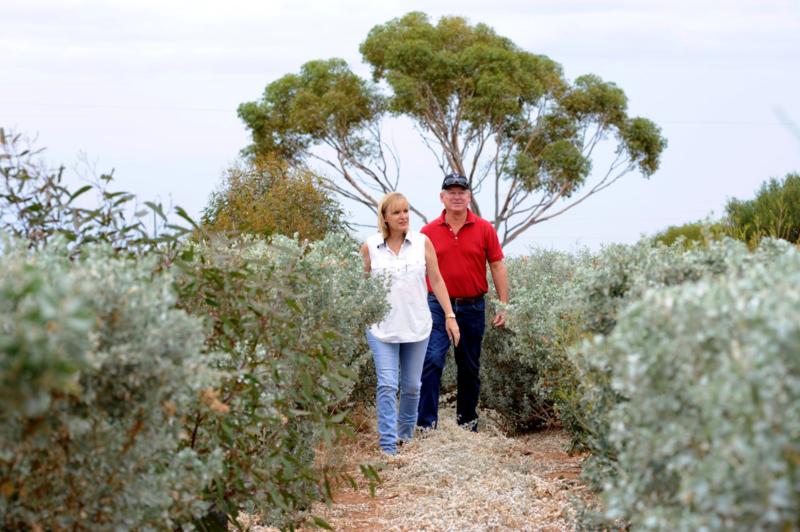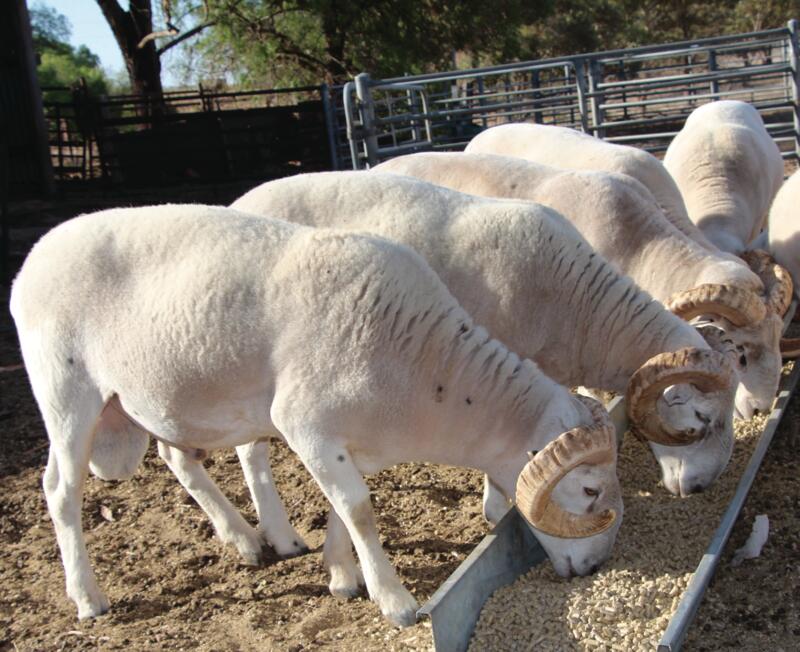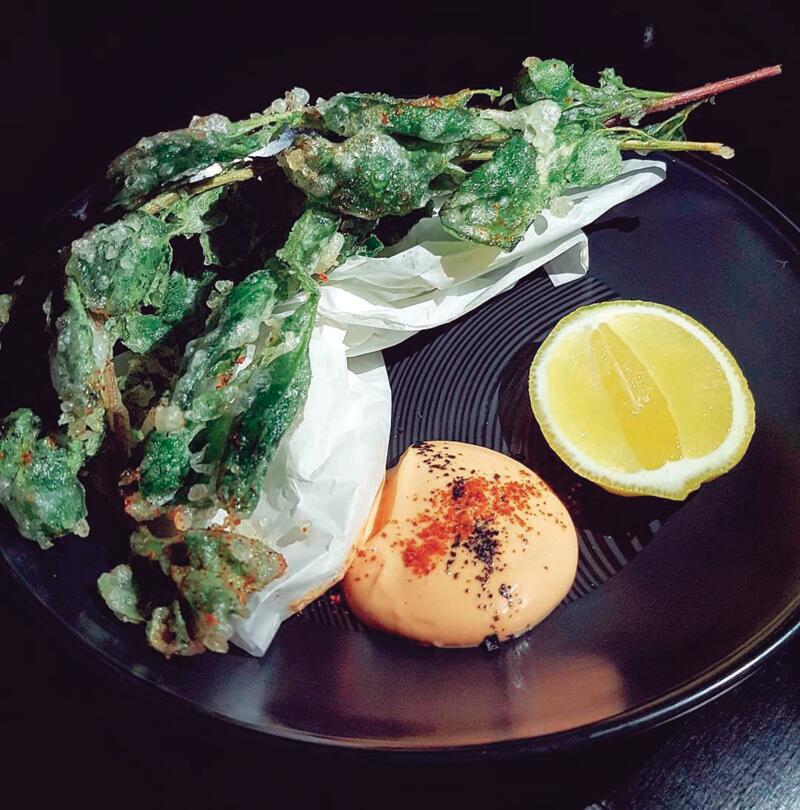BRIAN Wilson appreciated the benefits of the native shrub saltbush. He’d watched his sheep put on weight grazing bladder and river saltbush on one of his family’s farms between Crystal Brook and Port Broughton in South Australia.
He’d also noted that sheep grazing on saltbush alone did not do as well as when there were also other feeds in their diet, such as medics (temperate legumes) or clovers and grasses.
But it wasn’t until 2012, while Brian was in the Middle East watching sheep being fed pellets that the penny dropped. “In the Middle East, they grow little of their own feed and buy in pellets and hay from other countries,” Brian says.
“Back at home, saltbush is promoted as a living haystack and I began to think about the possibilities of harvesting the saltbush.
“From experience of grazing sheep on saltbush, I knew saltbush alone could not offer everything. We knew it did have protein so if we could add what was missing – the carbohydrate – by adding good quality hay and grain, we could pelletise the mix and feed it to stock.” So began a process that saw many twists and turns before the end product hit the market.
 Jill and Brian Wilson walking through old man saltbush.
Farming business fine tunes the saltbush pellet formula
Jill and Brian Wilson walking through old man saltbush.
Farming business fine tunes the saltbush pellet formula
The first stage was to conduct rudimentary trials to see if the concept was worth pursuing. When it became apparent they could be onto something, Brian and his wife Jill took an Australian patent out on the idea in 2014.
The Wilsons then approached a major South Australian pellet manufacturer, hoping it could produce the pellets for them to market. The timing, however, was not ideal. The pellet maker was inundated with orders to supply the live sheep and cattle trade, so the Wilsons had to find another manufacturer. Second time lucky. The next pellet maker took on the job, and when another side of its business, hay exports, took off, it offered to sell them the pellet production plant.
The Wilsons bought the plant and moved it to their farm at Clements Gap. A state government grant helped with the development of the facility, but getting it running took longer than expected.
“It was not without its challenges and it was a considerable investment,” Brian says. But by late 2015 they had produced their first commercial-size batches of pellets, ranging from 15 to 20 tonnes.
To expand the trials of the pellets, they teamed up with Elders. “We did a lot of work with Elders and their animal nutritionists,” Brian says.
“They were able to put us onto some of their clients who trialled the pellets and were able to measure things like growth rates and feed conversions. Partnering with Elders was one of the better things we did.”
Learning how to make the pellets and fine-tuning the formula weren’t the only challenges. The Wilsons also had to work out how to harvest their saltbush.
RELATED: Maggots: The livestock feed no-one saw coming
“We decided to use a very rudimentary forage harvester to harvest the saltbush, which basically cut it off and threw it into the back of a cart,” Brian says. “Harvest of the saltbush was one of the things we thought might be hard, but was easy in the end.”
How to harvest saltbush
The saltbush is cut at 20-30cm and is harvested twice a year, in autumn and late spring, as it grows the least in winter. Much of the saltbush that goes into the pellets is old man saltbush, harvested from the Wilsons’ plantations on their farm at Port Davis. They also harvest river saltbush once every two years as the bushes do not grow as quickly as old man saltbush.
 Wiltshire Horn sheep eating saltbush pellets.
Wiltshire Horn sheep eating saltbush pellets.
By late 2017, the Wilsons’ production plant was operating eight hours a day. The facility is capable of running 24 hours a day and to meet growing demand, they aim to plant 20-40ha of saltbush each year to add to the 150ha they already have.
As well as supplying the burgeoning demand for saltbush pellets, the Wilsons’ saltbush plantations provide feed for their own sheep, which are occasionally allowed to graze them. Alongside their pellet business, they have maintained their meat sheep production across four properties in the Mid North and Mallee regions of South Australia.
Saltbush offers livestock a valuable source of protein during drought
Since switching from wool to meat in the early to mid 1990s, they have been running Wiltshire Horn sheep as well as developing the new Poll Wiltshire breed, which they’ve been working on since 2005. With the current drought conditions, they are running about 5,000 sheep.
Brian sees huge potential for saltbush pellets, which are sold in bulk and also in one-tonne and 20kg bags to cater for a range of markets, and priced in line with other pelleted feed. Pellets are produced for sheep, cattle and goats, and there are three different types, varying in protein and energy to meet different feed requirements.
Elders has helped in promoting the innovative feed, but Brian says word of mouth is also proving very effective. Saltbush pellets have been shipped as far north as Cunnamulla, Queensland, to supplement drought- affected stock.
RELATED ARTICLES:
26-year-old silage offers drought relief for Tamworth farmer
Drought affected farmers: “We'll get through it"
How drought is affecting red meat prices – the highs and lows
While the drought has increased demand for pellets, it has also resulted in shortages of hay, and Brian says it has been a struggle to find enough to mix with the saltbush to make the pellets. It is yet another challenge for the fledgling business. But Brian isn’t deterred.
“It certainly has been rewarding to take an idea that no-one had done and to have a proof of concept,” he says.
“Saltbush is one of the oldest grazing species in Australia and is now the newest form of pelletised stockfeed.”
“I’d like to think in my lifetime saltbush will become a commodity and mainstream, from grazing it to making it a feed that can be transported anywhere in Australia and the world. It is an amazing resource that can help drought proof agriculture.”
Farmers create new product markets with saltbush lamb
.jpg) Lambs grazing on saltbush.
Lambs grazing on saltbush.
Saltbush is both an old and a new business for the Sippel family in Narromine, Central West NSW.
Andrew Sippel has long been promoting its benefits and supplying saltbush seedlings to farmers across the country. More recently, his son Ben has added value to the business by selling saltbush lamb, marketing the unique qualities of meat from stock grazed on the hardy native plant.
RELATED ARTICLES:
Emu oil finally takes flight in the Australian market
A cracking good idea pays off for Australian pecan producers
Mudgee seed business takes on multinationals
When Andrew, who grew up on a horticulture and cattle farm on the coast, moved to Narromine to take a job as revegetation manager with Yates Seeds Australia in 1987, his interest was piqued by saltbush. He saw it could thrive in Australian conditions but was only found in small areas.
“I read that the Riverina survived the droughts from the late 1800s to the early 1920s thanks to bladder and old man saltbush,” Andrew says.
He started propagating old man saltbush for Yates and estimates he has helped establish about 80 million saltbush plants since 1987.
.jpg) Andrew Sippel at his Narromine saltbush propagation farm.
Andrew Sippel at his Narromine saltbush propagation farm.
The stars aligned when Yates decided to sell its Narromine propagation business in the early 1990s. Andrew bought it and set up his own company to produce saltbush seedlings. He now sells about five million seedlings a year from the Narromine base, and says he could sell more if the seasons were better.
“We were doing two to three million seedlings a year at the start and it peaked in the late 1990s, but the droughts took the sting out of it,” Andrew says.
During the drought, his challenge has been to set the business up so he is ready to supply more seedlings when demand rises, but not to overcapitalise.
“We could grow 20 million plants,” he says. “You need to find the line between being cost effective in propagation and having the infrastructure and the ability to ramp up when demand lifts.”
.jpg) A saltbush seedling at the Narromine nursery.
A saltbush seedling at the Narromine nursery.
The business employs 15 to 20 people, mainly women with young families who work a few hours a day. Andrew says offering flexible work hours has been integral to keeping his workforce.
While Andrew has been busy propagating saltbush, his son Ben has been growing another side of the family business. After returning to Narromine in 2007, Ben started marketing saltbush lamb in farmers’ markets across Sydney, and quickly ramped up to four trucks supplying 10 to 12 markets a weekend.
However,
the fickle nature of farmers’ markets, where bad weather can reduce attendance, meant there was a constant carryover. “We had three or four big chest freezers and we would freeze meat and try to sell it the next week but some people just didn’t want to buy frozen meat,” Ben says.
He finally wound the business up in 2013, but a core of devoted customers kept asking when the saltbush lamb would be back. “A following and a passion for the product had developed,” Ben says, so he started offering saltbush lamb online, with customers able to buy a pack, a half lamb or a whole lamb.
.jpg) Ben Sippel sells prime lamb cuts and later successfully introduced slow-cooked-saltbush-lamb and gravy packs to help increase sales of other cuts.
Ben Sippel sells prime lamb cuts and later successfully introduced slow-cooked-saltbush-lamb and gravy packs to help increase sales of other cuts.
“People love the flavour, the quality and the story that goes with saltbush lamb,” Ben says.
He now sells about 20 lambs online every month. While he started out breeding his own lambs, he now sources them from a producer who is running lambs on saltbush country. The lambs are transported for processing in Nyngan before being butchered in Dubbo.
Ben still had a dilemma of having high sales of prime cuts and lower sales of other cuts, until the family came up with the idea of selling slow-cooked saltbush lamb and gravy packs.
Ben now sells the lamb and gravy packs, prepared at the family’s hotel in Gilgandra, as well as attending up to 40 events a year selling saltbush lamb and gravy in rolls.
“It is good exposure for our brand and we can now market the whole animal successfully,” he says.
Demand for saltbush flavours hits Australian restaurants
 Saltbush and chilli.
Saltbush and chilli.
The humble saltbush, steel blue in colour and rich in protein, antioxidants and minerals, has found its way into kitchens and restaurants. Chefs have taken to its versatility and punchy flavour, whether it be blanched, sautéed, wrapped around meat or used in salads.
“There is definitely interest in saltbush in terms of media coverage and high-end restaurant use,” says Melbourne spice merchant Maria Konecsny who sells the dried leaves.
RELATED: Poultry farmers innovate with black-skinned chicken
“Demand for saltbush has been steady since we started selling it in 2009 but it hasn’t drastically increased like some other bush ingredients we sell.
“Saltbush has a unique and distinctive flavour profile. It is salty, yes, but a soft saltiness, not sharp like refined salt. It is also herby, but not like a European herb and it sits somewhere between grassy and herbaceous.”
Culinary tips for saltbush
- Best cooked with a level of moisture to soften it rather than a dry rub.
- Makes a good salt substitute.
- Needs to be finely ground so its texture does not dominate the dish.
- Use as a wet rub on meats, or to add to and refine creamy sauces or gravies.
- Recommended for salads, breads, pork and game meat.
The benefits of saltbush in livestock feed
- Saltbush (Atriplex) is ideal fodder in drought as it grows in dry conditions.
- It can also improve the health of the land, putting down deep roots that open up channels in the soil allowing biota to flourish.
- It can help reduce soil salinity and erosion, and repair scalds as it thrives in saline soil.
- Stock grazed on saltbush produces leaner, moister and, many say, better-tasting meat.
- Lambs grazing saltbush prior to processing have leaner carcases with higher meat yields and higher vitamin E levels. Vitamin E is associated with maintaining meat redness and extending shelf life.